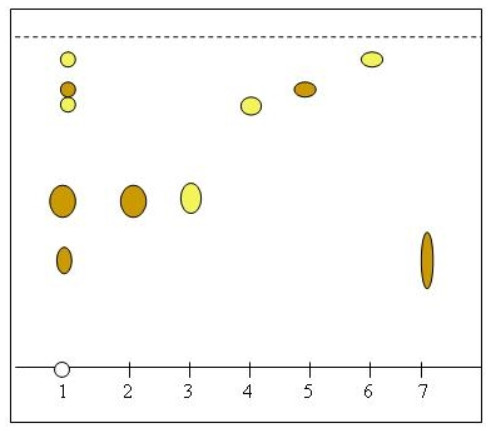PHYTOCHEMICAL STUDY OF AERIAL PARTS OF TARAXACUM OFFICINALE WIGG.
Abstract
As the results of the chemical study of the aerial parts of the dandelion (Taraxacum officinale Wigg.) there were isolated for the first time the caftaric acid (21-caffeoyltartaric acid), tricin (5,7,41-trihydroxy-31,51-dimethoxyflavone), caffeic acid, chlorogenic acid, luteolin (5,7,31,41-tetrahydroxyflavone), cynaroside (7-О-b-D-glucopyranoside of 5,7,31,41-tetrahydroxyflavone) and taraxasterol (triterpene saponin), chemical structures of which there were elucidated for the first time by means of 1H-NMR-, 13C-NMR-, UV-spectroscopy, mass spectrometry and several chemical transformations (acid an enzymatic hydrolysis).
There were substantiated the expediency of the using for the determination of identity of the new type of medicinal vegetable raw materials of Taraxacum officinale herbs of TLC by means of the detection of the dominating phenylpropanoid, caftaric acid in the presence of state standard sample of cynaroside, having comparable values of the size of Rf with the analyzed compound.
For pharmacopoeial chromotographic analysis of of Taraxacum officinale herbs there was recommended the using of the chromotographic plates «Sorbfil PTSKH-AF-A-UV» in the solvent system: chloroform n-butanol-ice acetic acid-water in the ratio of 4 : 1 : 2 (detection of compounds on chromatograms in UV light at wavelength 254 nm and by means of the spraying with thealkaline solution of the diazobenzolsulfoacid.
Downloads
Metrics
References
Государственный реестр лекарственных средств. Т.1. Официальное издание. М., 2008. 1398 с.
Государственная фармакопея СССР. Общие методы анализа. Лекарственное растительное сырье. МЗ СССР. М., 1990. Вып. 2. 400 с.
Куркин В.А. Фармакогнозия: учебник для студентов фармацевтических вузов (факультетов). Самара, 2007. 1239 с.
Муравьева Д.А., Самылина И.А., Яковлев Г.П. Фармакогнозия: учебник. М., 2002. 656 с.
Куркин В.А. Основы фитотерапии: учебное пособие для студентов фармацевтических вузов. Самара, 2009. 963 с.
Растительные ресурсы СССР. Цветковые растения, их химический состав, использование. Семейство Asteraceae (Compositae). СПб., 1993. 352 с.
Азнагулова А.В. Особенности стандартизации нового вида лекарственного растительного сырья – травы оду-ванчика лекарственного (Taraxacum officinale Wigg.) // Аспирантский вестник Поволжья. 2014. №5-6. С. 150–151.
Terencio M.C., Giner R.M., Sanz M.J., Máñez S., Ríos J.L. On the Occurrence of Caffeoyltartronic Acid and Other Phenolics in Chondrilla juncea // Zeitschrift für Naturforschung. 1993. Vol. 48C. Pp. 417–419.
Maas M., Petereit F., Hensel A. Caffeic Acid Derivatives from Eupatorium perfoliatum L. // Molecules. 2009. Vol. 14. Pp. 36–45.
Медведев Ю.В. Исследование содержания фенолокислот в лекарственном и пищевом растительном сырье ме-тодом ВЭЖХ : автореф. дис. … канд. фарм. наук. М., 2010. 24 с.
Диетология: руководство / под ред. А.Ю. Барановского. СПб., 2013. 1024 с.
Куркин В.А., Запесочная Г.Г., Дубичев А.Г., Воронцов Е.Д., Александрова И.В. Фенилпропаноиды каллусной культуры Rhodiola rosea // Химия природных соединений. 1991. №4. С. 481–490.
Куркин В.А., Запесочная Г.Г., Клязника В.Г. Флавоноиды корневищ Rhodiola rosea // Химия природных соеди-нений. 1982. №5. С. 581–584.
Kurkin V.A., Kharisova A.V. Flavonoids of Cartamus tinctorius flowers // Chemistry of Natural Compounds. 2014. Vol. 50. N3. Pp. 446–448.
Технология «Секреты долголетия» / Одуванчик-П [Электронный ресурс]. URL: http://www.secret-dolgolet.ru/tekhnologiya-sekrety-dolgoletiya/oduvanchik-p.html.
Shakeri A., Ahmadian M. Phytochemical studies of Some Terpene compounds in roots of Cynara scolymus // Interna-tional Journal of Farming and Allied Science. 2014. Vol. 3. N10. Pp. 1065–1068.
European Pharmacopoeia. 8-th Ed. Vol. 1. Strasbourg: Council of Europe, 2014. 1456 p.
Pharmacopoeia of the People’s Republic of China. Vol. 1. Chinese Pharmacopoeia Commission, People’s Medical Pub-lishing House, 2005. 975 p.


This work is licensed under a Creative Commons Attribution 4.0 International License.
The authors, which are published in this journal, agree to the following conditions:
1. Authors retain the copyright to the work and transfer to the journal the right of the first publication along with the work, at the same time licensing it under the terms of the Creative Commons Attribution License, which allows others to distribute this work with the obligatory indication of the authorship of this work and a link to the original publication in this journal .
2. The authors retain the right to enter into separate, additional contractual agreements for the non-exclusive distribution of the version of the work published by this journal (for example, to place it in the university depository or to publish it in a book), with reference to the original publication in this journal.
3. Authors are allowed to post their work on the Internet (for example, in a university repository or on their personal website) before and during the review process of this journal, as this may lead to a productive discussion, as well as more links to this published work.











